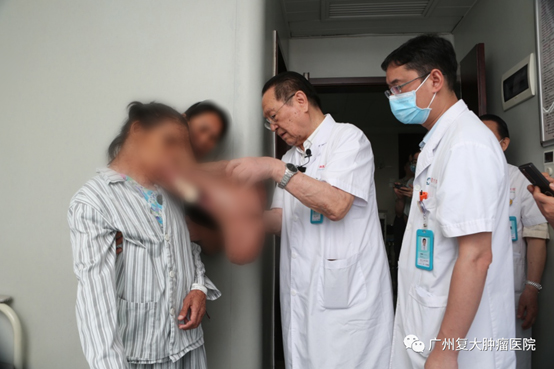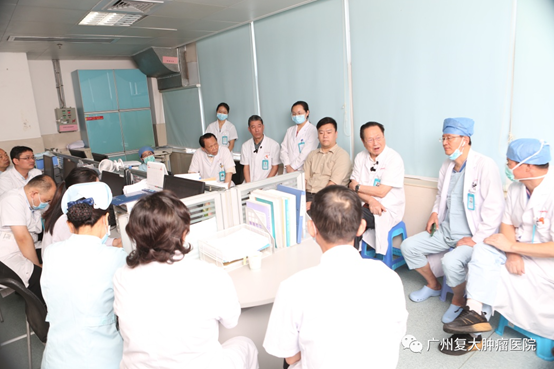(Warning: The following videos and pictures may cause readers’ discomfort.)
The long sarcoma hangs down from her face to her stomach. Most of her face is covered. Her eyes, mouth, and nose have "disappeared", and there are dense small tumors all over her body. Recently, staff of Guangzhou Fuda Cancer Hospital (Fuda) is working hard for Haimei, an "elephant-faced" patient.

Haimei, who was born in Guangxi, has a long sarcoma on her face for decades. The tumor started protruding from her left side of face since she was four or five years old but it didn't arouse any attention. It wasn't until the tumor continued to grow that she went to the local hospital for consultation and found out that it might be neurofibromatosis.
"At the age of 7, her left eye began to lose sight; at the age of 15, the tumor grew to the cheek; at the age of 20, the tumor reached the neck, and her body was found with small sarcoma; At the age of 30, the tumor had reached the chest, for which she felt difficult to move.” Haimei’s younger sister told us. Haimei has 4 children and her husband became disabled after a car accident. She earned from farming and she is one of low-income households in the village.

She couldn't afford to go to a major hospital due to poverty while couldn't be treated at small hospitals. Therefore, she didn't receive any treatment. Now Haimei's sarcoma has reached her stomach, weighing more than 10 kilograms, and her eyes, nose, and mouth have been compressed and severely deformed. She has lost her left eye sight and teeth with hearing loss, and always feels dizzy and uncomfortable.
“We have consulted several doctors but most of them couldn’t offer us treatment plan and told us to give up,” Haimei’s younger sister came across that a Hunan patient who also had a 15kg tumor on her face and was successfully treated at Fuda with the funding raised by media and society. After further investigation, they came to Fuda, seeking for help.
"The tumor is huge with rich blood vessels inside, so the risk of surgery is very high," Chief president Xu Kecheng said. A jointed opinion of Imaging department, Anesthesiology department, and Head and Neck department suggest that the patient should be treated in different times to meet the needs of burden relief and life quality improvement. To achieve the goal, nutrition should be maintained before and after surgery, while the relationship between the tumor and surrounding organs and tissues as well as their blood supply needs to be further evaluated. During the surgery, surgeons have to be careful enough to avoid causing any damage to important blood vessels and nerves, and be alert to the risk of detachment of the tracheal intubation.

Fuda has performed many similar surgeries before. For example, Xiaohong and Ajia (pseudonym), known as “elephant-faced” patients from Malaysia, have returned to normal life with the help of the Fuda medical team. Now Fuda has gathered experts and organized multiple discussions. Haimei is undergoing nutrition conditioning and respiratory function exercise at the hospital, and the first surgery is scheduled on July 19.
Considering the abnormal tumor size, multiple surgeries and postoperative rehabilitation are needed, which will cost around 300,000 RMB in total. The leaders of the hospital expressed that they would leverage all medical resources to help her tide over the difficulties. Prof. Xu Kecheng would offer nutritional support for the patient in the name of Xu Kecheng Workshop for Health Care. Besides, he called on social charity enthusiasts to reach out their helping hands, pulling her and her family out of darkness.

Prof. Yenni Thamrin, Chairman of Per-wanti PSMTI and also Chairman of the Indonesian Diaspora Network-China, visited the patient.
Medical Tips: What is “elephant face”?
Neurofibroma is an autosomal dominant genetic disorder featured skin hyperpigmentation, cafe-au-lait spots, elephantiasis, and multiple skin neoplasms with ocular and skeletal lesions. Neurofibroma is gray in color, soft in texture, and could hang like a bag. In some cases, tumors on the face pile up as a "monster-liked" appearance - so called "elephant face".
Surgical resection is currently an effective treatment. However, multiple neurofibromas are usually scattered and they invade deep tissues, or the tumor is large in size without clear boundaries so it is difficult to remove all the tumors separately or completely. Sometimes we need to arrange several surgeries for patients.

